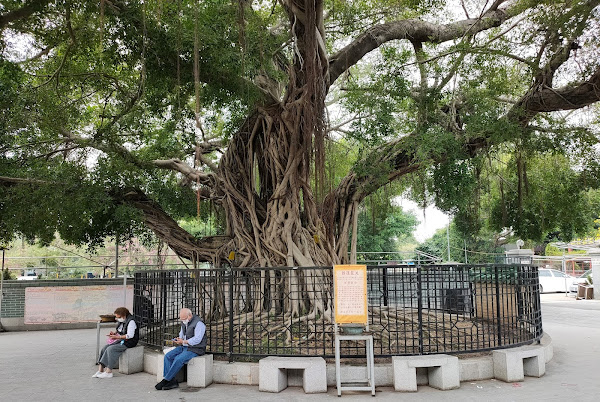Whenever I’m exploring a new area on my bike, my main purpose is to find new paths that I can incorporate into a longer ride. However, I do find other things of interest, such as the murals that I discovered last winter in the Tam Mei valley, none of which I would ever have seen had I not been looking to extend my original route through the valley.
Another example of a serendipitous discovery has been the ‘big tree temple’. I started to explore the area known as Shap Pat Heung (‘eighteen villages’), south of Yuen Long, last winter. I’d started by following a path that ran alongside an unnamed tributary of the Kam Tin River as far as a gazebo that is erroneously included on Google Maps as an ‘historical landmark’ (it isn’t; such structures are ubiquitous throughout the northern New Territories), with the intention of returning along the opposite bank of the river.
However, I couldn’t help but notice how many paths and alleyways led off the path I was on, and naturally I wanted to see whether any of them led anywhere interesting. One of the first paths I ventured down led, eventually, to a temple, although on that first visit I didn’t stop to take any photos. I did want to see, though, whether I could find a second route to the temple and thus have a contiguous circuit.
I’ve now done this. The following photo shows where I decided to turn off my original route (continuing straight on at this point leads to the temple):
Following this path leads to a large area of modern village houses with narrow roads in between, and at one point I came to what I thought was a dead end. However, I spotted a possible exit, which did look rather tricky, but it was the only option:
…and it did lead, eventually, to the temple.
The Tai Shu Ha Tin Hau Temple (‘Tin Hau temple under the big tree’—Tin Hau is the Taoist goddess of the sea) was probably built in 1786. I’ve found several references to a date stone, which I’ve not seen. Local tradition has it that the temple is even older, but I suspect that this refers to an earlier structure on the same site. The temple underwent extensive renovation in 1856—also recorded somewhere on a stone tablet. Ceramic tiles were added to both the interior and exterior walls in 2004, which according to the government website I consulted “very much diminished the authenticity of the temple”. However, it is a Grade II listed building and is definitely worth a visit.
This is a general view of the front of the temple:
I took the next three photos (from left to right) to highlight the denigrated ceramic tiles on the front elevation:
These photos also show the complex array of flowers and birds on the roof ridge—the round red object directly above the left-hand door represents a pearl.
This is a closer look at the left-hand doorway:
…while this is a close-up of the traditional Chinese landscape painting directly above the doorway:
And this is the right-hand doorway:
…followed by a close-up of the area above the doorway:
The murals probably depict scenes from Chinese literature, although that is just a guess based on having seen such scenes adorning other temples.
You may have noticed a QR code within a green border in several of the photos, which is part of the local anti-covid strategy. You are expected to scan it if you enter the temple, and although I do have the necessary app on my phone, I had no intention of venturing inside. First, I don’t wear a mask when cycling; and, second, I don’t want to upset or offend people for whom this is an important cultural centre by going inside and taking photos, although I have seen photos of the interior, and it does look interesting.
And you’re probably wondering about the reference to a big tree:
It’s a banyan, and it’s purported to be hundreds of years old. I suspect that this is an exaggeration. It certainly cannot have been planted deliberately, because banyans are epiphytes, starting life in the crevices of other trees and as they send down roots, slowly strangling the host tree. It also appears that the roots that have reached the ground have been trained deliberately to remain close to the main trunk, because, if left unchecked, aerial roots thicken and become woody some distance from the main trunk. I’ve seen such ‘prop roots’ up to 35–40cm in diameter.
On the way back to my starting point beside the river, my route passes a bougainvillea, which adds some pleasant colour to the ride:
I could simply continue to follow my original route in reverse, but at the point where I turned left on the route to the temple, I decided to turn right:
…because, after a very short distance, I could turn left where the route to the temple turns right:
All the cycling photos in this post are the result of a mysterious malfunction with Paula’s video camera. We were supposed to be shooting a video, but what we got instead was a long series of still photos. I expect to rectify this in due course. Unfortunately, however, I recently aggravated a long-term lower back injury that hadn’t bothered me for years, and I haven’t been able to get on a bike for the past two weeks. I should be getting back to business fairly soon though.
Thursday, 9 December 2021
Subscribe to:
Post Comments (Atom)
















Hope that a video can be taken by the GoPro and not series of photos.
ReplyDeleteWell you’re in charge of the camera!
Delete